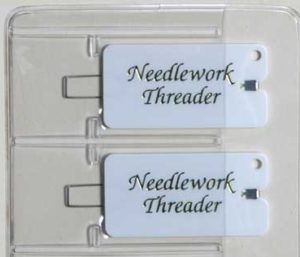
A large unfulfilled needlepoint desire I have is the lack of automatic needle threaders for needlepoint. I have been looking for one for ages, and I have tried others and found them lacking. I use regular needle threaders all the time; my favorite is pictured above. I have many different ones, and I use them all. There are ones at my desk, ones on the table by my stitching chair, and ones in most project bags.
Even so, I still long for a threader that will do some of the work for me. Today I will describe how automatic threaders work and then the reason most of them don’t work. Finally, I will look at two specific threaders and describe the problems with them.
How Threaders Work
All automatic threaders work similarly. The needle is held steady. The thread ultimately goes onto some hook or lever. The lever brings the thread into the threader and through the needle’s eye. The threaded needle is removed, and the thread is pulled through.
Sounds simple, doesn’t it?
The threaders I’ve seen differ in how the thread is loaded. Another difference is that some threaders require almost as much work to thread as threading a needle by hand.
Small-eye Threaders
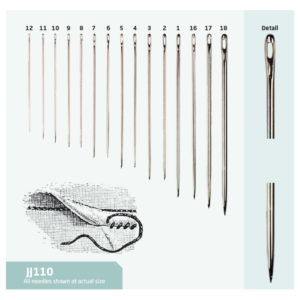
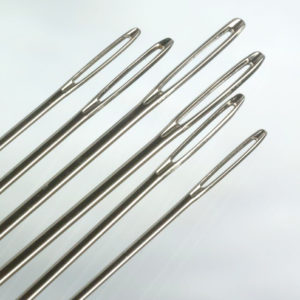
Sewing needles, top picture above, have small eyes near the top of the needle. Tapestry and chenille needles, bottom picture above, have large eyes that are slightly farther from the top.
The two types of needles can be classified as “small-eye” and “large-eye.” Most threaders are made to work
Assume that if it does not say that the threader works with large-eye needles, it will not work with tapestry needles. A second concern with automatic needle threaders is the size of thread they can use. Most of our needlepoint threads are too thick to work with these devices.
The problems with Large-eye Threaders
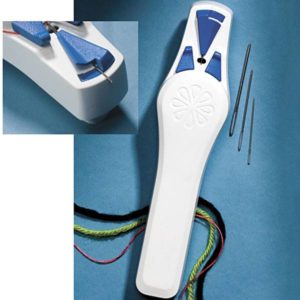
The first threader I saw that might work was this hand-held threader. I don’t remember the brand name. As you can see from the small picture, you insert the needle into the triangular slot at the top of the device with the eye over the hole at the bottom. The thread is laid over the two smaller triangles. The device is pressed, that’s not shown, and a hook comes up through the small hole and puts the thread through the needle.
It worked like a champ at first. I ha not problems with needle or thread size. I kept it away from getting jostled. But it only worked for a few days. Very quickly, the hook got out of alignment. Because you cannot move the needle in the slot, it would miss the eye and not thread the needle once that happened.
We could not figure out a way to adjust things to make it work.
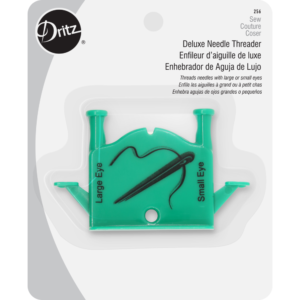
Most recently, I used the Dritz automatic needle threader. It’s similar to other desk threaders and has holes for both small- and large-eye needles. It needs to be on a flat surface to work. I tried it with both #20 and #22 needles. The #20 needle was too thick to fit into the hole. The #22 would only fit if I aimed it just right, so it went straight down. Obviously, to get it to thread, the hole has to be oriented correctly before inserting it.
Once the needle was in, we tried to use it. The thread is delivered to the needle using a small lever that comes out of the side when the pad is pressed. The lever is very thin and short, making it hard to see (I missed it the first several times I looked for it.) I was using Glisten, which is a typical thickness for needlepoint thread. The entire thread could not be placed on the lever; parts of the thread kept getting caught on the tip of the lever.
After abandoning using it, I kept trying to think if there were threads that would work on 18 mesh that would not be damaged this way. I could think of very few.
Although I have not found a threader that works, I am still hopeful. When I do, I’ll let you all know.
About Janet M Perry
Janet Perry is the Internet's leading authority on needlepoint. She designs, teaches and writes, getting raves from her fans for her innovative techniques, extensive knowledge and generous teaching style. A leading writer of stitch guides, she blogs here and lives on an island in the northeast corner of the SF Bay with her family

Leave a Reply